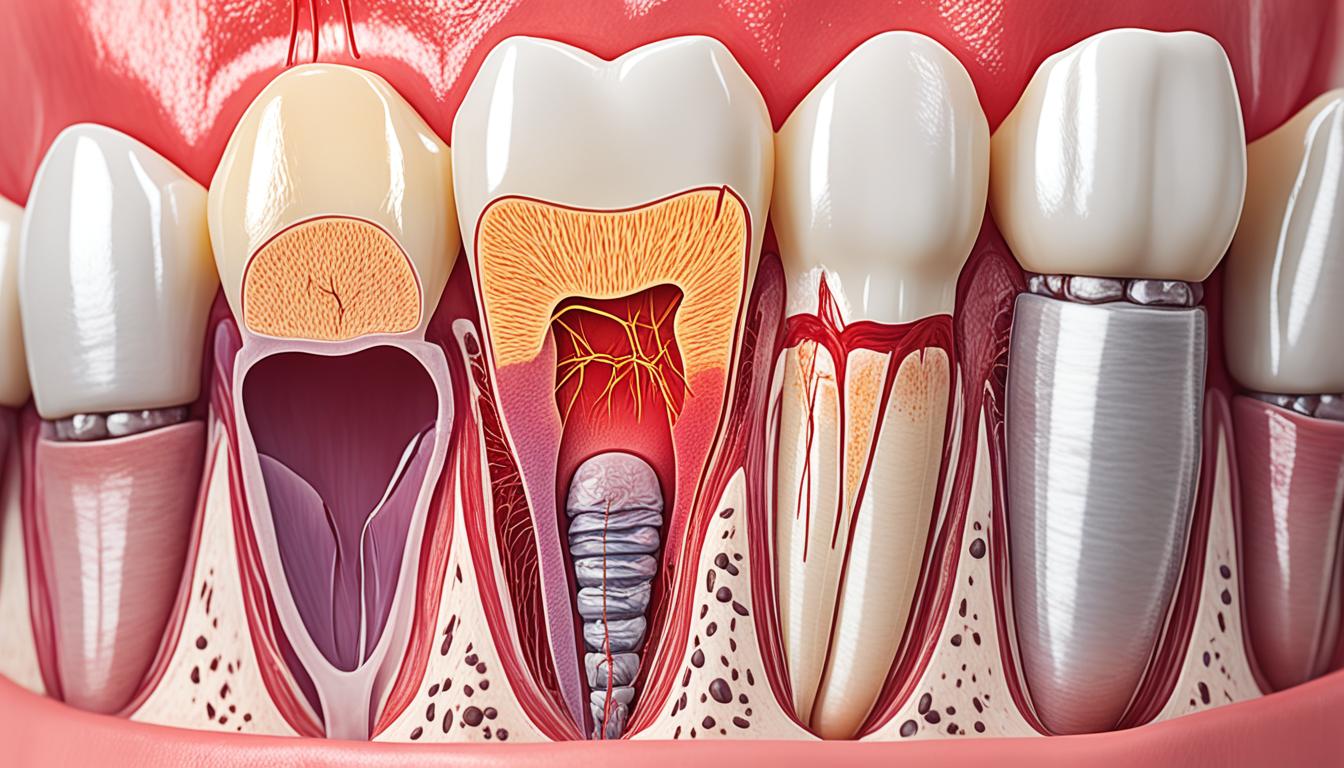A tooth abscess is a bacterial infection that causes pus to gather in the gum or teeth. It is a painful condition that needs immediate medical treatment. Knowing the signs, causes, how it is diagnosed, and treatment options is key to good oral health.
The symptoms of a tooth abscess are severe pain, gum swelling, and a fever. They can make life hard, affecting eating and speaking.
Many things can cause a tooth abscess, like tooth decay, tooth trauma, or an infected wisdom tooth. It’s important to find and treat these causes to prevent more infections.
Diagnosis involves a dentist looking closely at the tooth and possibly taking x-rays. Finding it early can prevent further problems and help with treatment.
The treatment for a tooth abscess depends on how bad the infection is. Sometimes, the pus needs to be drained to reduce pain. Pain meds, antibiotics, and mouthwash can also be given to fight the infection and help healing.
In worse cases, a root canal or tooth removal might be needed. These steps help get rid of the infection and stop more problems. Always see a dentist quickly, as leaving it untreated can have serious results.
New treatments like stem cell therapy show promise for tooth abscesses. Adult stem cells and iPS cells can maybe help regrow the tissue damaged by the infection.
But, we need more studies and tests to make sure stem cell therapy is safe and effective for tooth abscesses. Still, this way of treating dental infections could change things for the better.
Key Takeaways:
- A tooth abscess is a bacterial infection that results in the accumulation of pus in the gum or teeth.
- Symptoms of a tooth abscess include intense pain, gum swelling, and fever.
- Causes of tooth abscess include tooth decay, trauma, or wisdom tooth infection.
- Treatment options include drainage, root canal treatment, and tooth extraction.
- Stem cell therapy shows promise in regenerating damaged dental tissues, but further research is needed.
Treatment of Tooth Abscess
Dealing with a tooth abscess needs quick action. It’s vital to see a dentist right away. Treatments can include draining the abscess, a root canal, or pulling the tooth out.
If the abscess is big, the dentist might drain it to get rid of the pus. This can lower your pain and stop the infection from spreading. You might also get painkillers, antibiotics, and mouthwash to ease symptoms.
Root canal therapy might be needed for more serious abscesses. This is when the tooth’s center is badly infected. The procedure cleans out the infection within the tooth. It’s a way to save your tooth, preventing the need for extraction.
Sometimes, a tooth abscess happens with a break in the tooth. In these cases, the dentist might drain the abscess and then remove the tooth. This is done to stop the infection from spreading further. Tooth pulling is a last option if it can’t be saved.
Treatment Procedure Overview
The first step is usually to drain the abscess to relieve pain and remove the pus.
You’ll likely be given painkillers, antibiotics, and mouthwash to help manage the infection.
Root canal treatment might be the chosen path to remove the infected pulp and save your tooth.
Lastly, if saving the tooth isn’t possible, the dentist will remove it.
Never ignore a tooth abscess; it can lead to serious health problems. These include heart infections and even brain abscesses.
| Treatment Options | Description |
|---|---|
| Drainage | Removal of pus from the abscess area to relieve pain and prevent further infection. |
| Root Canal Treatment | Removal of infected pulp, cleaning of root canals, and filling to eliminate the infection and preserve the tooth. |
| Tooth Extraction | Removal of the abscessed tooth in cases where other treatment options cannot save the tooth. |
| Complications | Periodontitis, tooth loss, heart infection, brain abscess, Ludwig’s angina. |
Stem Cell Therapy for Tooth Abscess
Stem cell therapy is showing great promise in treating problems in the mouth and face, like tooth abscess. These cells don’t have a fixed job yet and can become many different kinds of cells. This makes them perfect for helping damaged tissues heal.
Experts have been looking into how well adult stem cells and reprogrammed stem cells (known as iPS cells) can fix dental issues. They are focusing on ways to find and use the best stem cells. They’re also figuring out how to make the right environment for these cells to grow and change into the types needed for healing.
Although using stem cells looks very hopeful for fixing tooth abscess and other mouth problems, there’s still a lot to learn. More studies and tests are necessary to fully understand and apply this new method.

